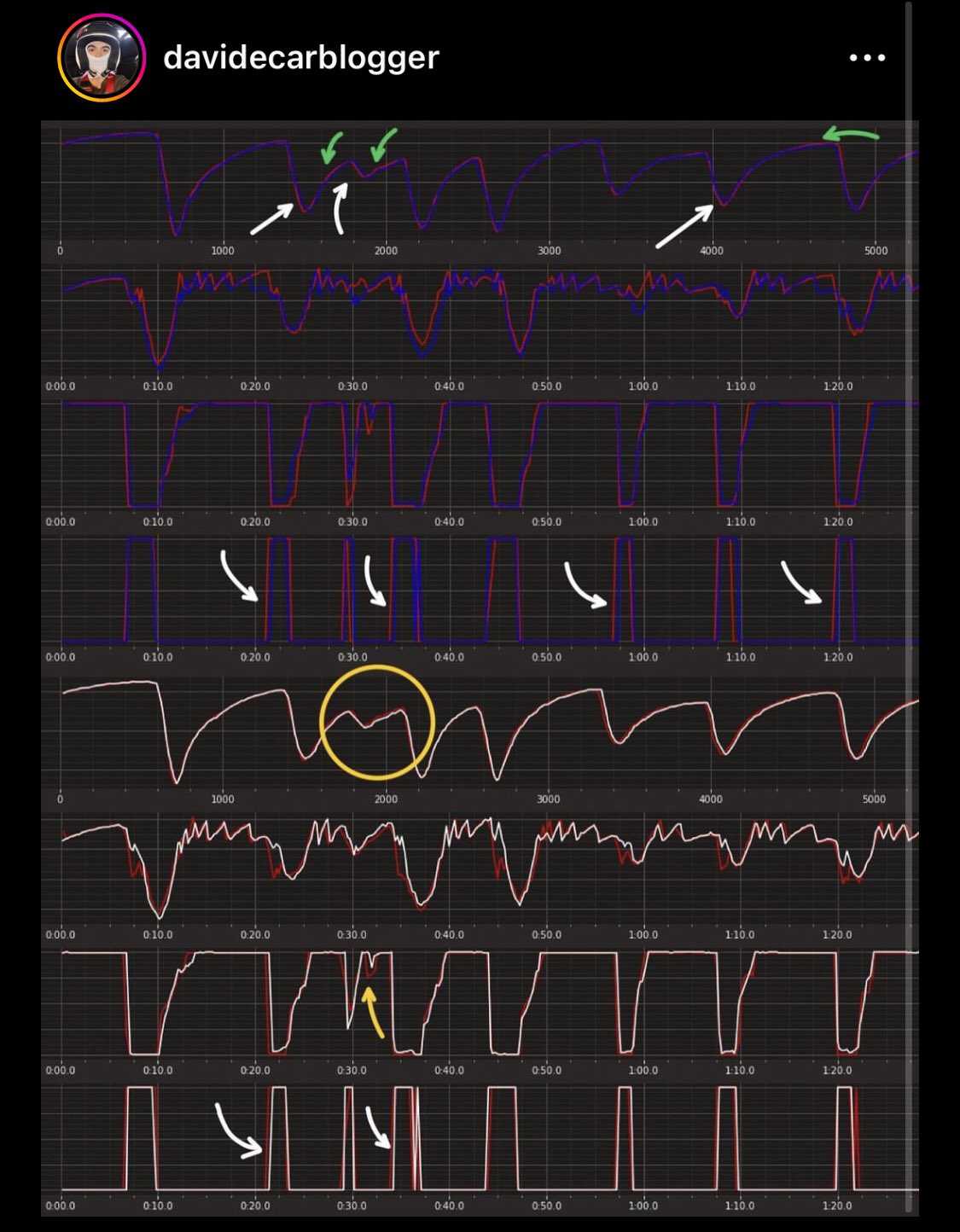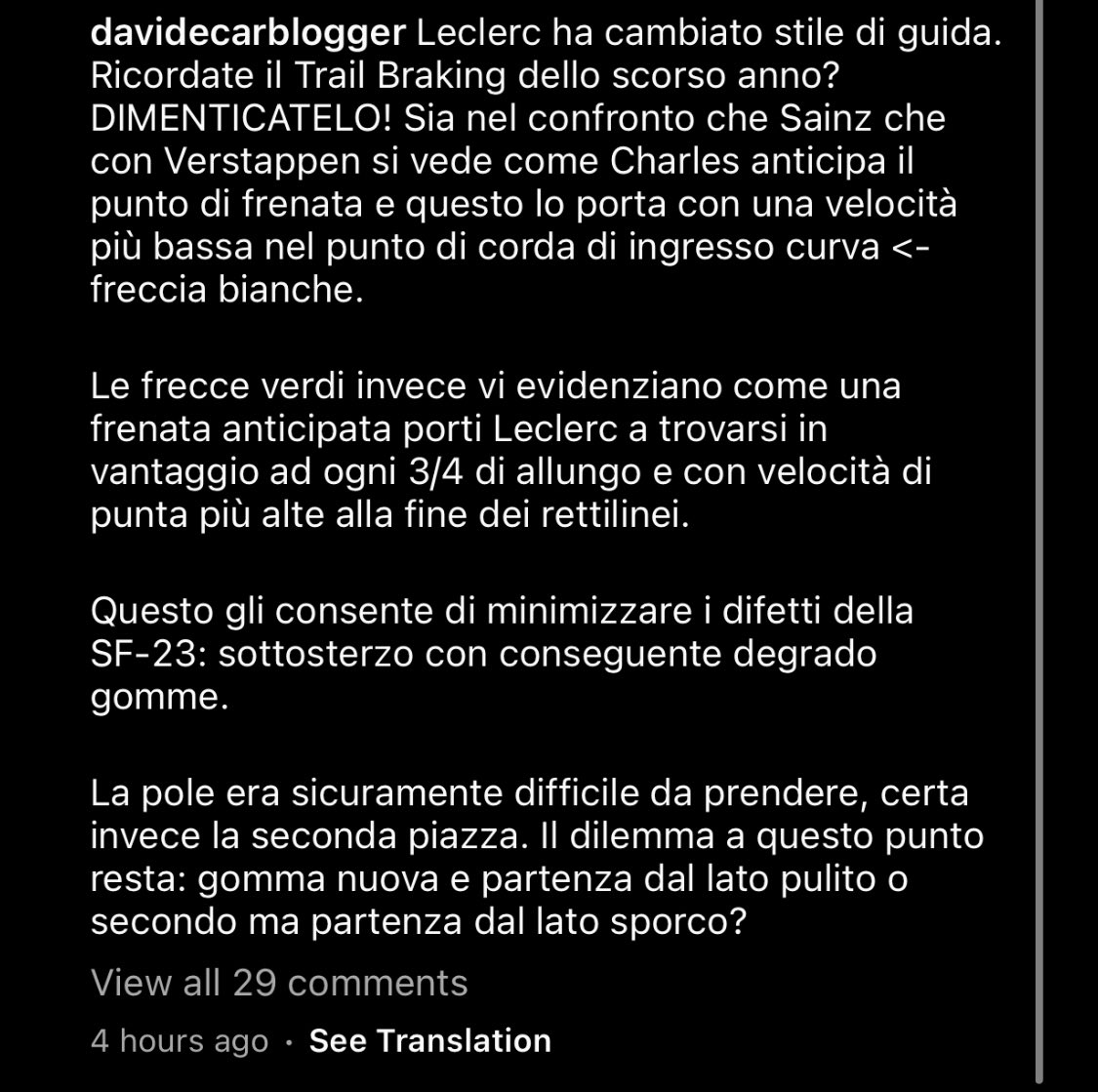Andi76 wrote: ↑05 Mar 2023, 10:29
On motorsport.com Matt Kew has published a good analysis of the GPS data from the SF-23 and the RB19:
"...the RB19 can't be caught at early power, even if Leclerc was able to get back on the throttle faster in the tight first corner, looking ahead to the decisive Q3 laps.But Verstappen's advantage is only short-lived: on the back straight towards turn 4 it's the SF-23 that has the higher top speed at 304 km/h - Verstappen only gets to 301 km/h. Interestingly, this is once again exactly the opposite of last year, when Red Bull had the upper hand on the straights. The RB19 seems to have more downforce, as Verstappen is faster in the right-hand corner and the more brutal medium-fast Turn 7. In the fluid middle section in between, however, Leclerc again dictates the pace. And that's the trend for the rest of the lap, too: Red Bull accelerates better out of the notorious Turn 10, a downhill left-hander, and takes more speed through the uphill Turn 12. Verstappen finds time again in Turn 13, too, and has an advantage before the penultimate straight, but the low-drag Ferrari makes up for it by arriving four km/h faster in the final braking zone.
At the apex of the final corner, the Ferrari is actually faster, just as it was in 2022, before the Red Bull sets the benchmark again on acceleration. Only at the finish line can the Ferrari crack the RB19's speed of 293 km/h again."
In relation to the Aston Martin, the SF-23 loses especially in the braking zones and the slow apexes. Alonso's car has, according to his analysis, the better mechanical grip, but is also the slowest of the three cars on the straights, where he then also loses a lot of time compared to the SF-23.
I think this shows that Ferrari worked on the weaknesses of the F1-75 in the SF-23, but they had to trade some of its strengths for it. Since Red Bull, at least in this analysis, seems to have done the same, the roles are reversed to 2022 - the Ferrari is the faster car in terms of top speed while the Red Bull gains time in the corners. What is not taken into account here, however, is that there will still be some change in the SF-23 in terms of downforce. The new rear wing, which Ferrari says is a "project," seems to aim to make up for the lack of downforce on the rear axle compared to Red Bull with comparatively minimal gains in drag. If the front axle can be compensated accordingly, I think it doesn't look too bad that Ferrari retains a minimal advantage in top speed, but hardly loses anything in the corners.
This would also explain the confidence that prevailed after the tests and the relaxed mood after qualifying, which is in complete contrast to the suddenly emerging rumors about correlation issues and the statements made so far. Whereas everything fits together when you have achieved your goals and are aerodynamically very efficient and "only" need to complete a project to find the last points of downforce, knowing that this only reduces the advantage you have in terms of top speed to the extent that you are still faster, even if only minimally. The efficiency of the SF23 can be seen on this telemetry :
https://postimages.org/
Also that Leclerc often can go on the throttle earlier than Verstappen is encouraging.
Of course this is a speculation and a theory of mine, but if you take the facts, the statements of the engineers and the behavior of the whole team as a basis, a quite plausible and logical one. If they had actually correlated issues, which with a gap of 3 tenths to the excellent Red Bull and the fact that they have the second best car anyway sounds more like a joke, they would hardly be as relieved and confident as they were after qualifying.
Finally, the race today will finally reveal many question marks for us. It will be crucial if Ferrari has already overcome its biggest weakness with the SF-23. The longrun data itself (see yesterday's post) suggests that at least Leclerc's car is expected to show a strong improvement. However, this looked quite different with Sainz and the Red Bull, Aston Martin and Mercedes engineers rather predict that Ferrari will have strong problems. The driver has a very important role when it comes to tire desgradation. A race tire goes through various heat cycles during a race. Generally, a tire becomes harder after each heat cycle. Experienced drivers take good care of their tires and try not to let them build up too much heat. A more evenly heated tire goes through fewer heat cycles and maintains its optimal grip for a longer time. But also on the part of the tire manufacturers is already taken precautions here. A new racing tire, unlike cars on a normal road car, is not fully cured. Because of the extreme heat to which the tire is exposed, tire manufacturers leave parts of the curing process to the racers. If a fully cured tire were taken to the track, the tire would be much harder from the start, with corresponding effects on grip and lap times. Tire engineers understand that heat changes the rubber compound of the tire, so they plan ahead for the curing process to take place on the track. This is one of many reasons why race tires are much softer than normal tires and the driver has the task and control over how the tire is cured and how much it cures or stays in an optimal grip range. But other things also have an important influence. A racing tires actual compound softness when its in action is only partly to do with the base softness resulting from its ingredients. The other two main determinants are the tires temperature and the contact frequency. These work in opposite directions. When the temperature rises the compound becomes softer, when contact frequencies rises the compound becomes harder. The suspension is the tool that influences that and also is the tool to bring the tire to its optimum state, called vitreous transition. But its a delicate balancing act. Contact frequency is about how the loads react upon the rubber, what is not consistent becauser rubber is viscoelastic material. Up to a point the rubber will accept the incoming energy and react against it, trying to spring back in the opposite direction of the load and thereby creating grip. Beyond that point the rubber cannot regain shape quickly enough to absorb the next input. The contact frequencies get to high. This has the effect of stiffening and hardening the compound. The higher the contact frequency, the more temperature you need to compensate in order to keep the tire at its intended compound softness. So there are quite a few different influences and mechanisms that play a role here and I'm curious if the SF-23 and its drivers (both play a role, car and driver) work better here.
It also remains to be seen to what extent the Red Bull will be ahead in race pace. I wish everyone a lot of fun and am curious what will turn out. But I think that the SF-23 has great potential and can make bigger steps than the RB19.







